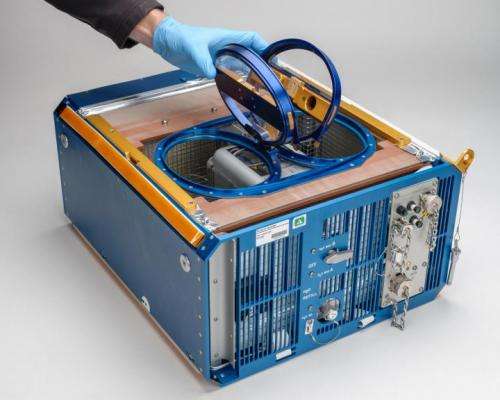Research with space explorers may one day heal Earth's warriors

Growing bone on demand sounds like a space-age concept—a potentially life changing one. Such a capability could benefit those needing bone for reconstructive surgery due to trauma like combat injuries or those waging a battle with osteoporosis. Related research is hardly science fiction, as a study into a key bone-growing protein was recently funded to take place in orbit aboard the International Space Station.
"This research has translational application for astronauts in spaceflight and for patients on Earth who have osteoporosis or other bone-loss problems from disease, illness or trauma," said Dr. Chia Soo, UCLA professor of plastic and reconstructive surgery and orthopedic surgery and member of the Eli and Edythe Broad Center of Regenerative Medicine and Stem Cell Research. Soo is also research director for UCLA Operation Mend, an organization devoted to providing medical care for wounded warriors.
Ground tests for an investigation known as Systemic Therapy of NELL-1 for Spaceflight-Induced Osteoporosis will begin this year. The NELL-1 protein, naturally occurring in humans, has the capability of forming bone at one site when implanted locally or at several sites when delivered through the bloodstream. For local bone formation, which is needed for reconstructive surgery, for example, doctors would directly implant NELL-1-infused osteoconductive scaffolds—a bone graft framework. To deliver systemically and treat the body as a whole, which could benefit osteoporosis patients, NELL-1 is bioengineered to remain active in the bloodstream until it reaches the bone.
By studying this protein aboard the space station, researchers hope the microgravity tests will reveal additional insights into how NELL-1 works. This may help refine and optimize future use of the protein therapy in humans on Earth.
"The space station offers wonderful opportunities for translational medicine. When something is looking great in the lab, we can learn a little bit more about it in space. That then can help towards new treatments for disease," said Julie Robinson, Ph.D., NASA's Chief Scientist for the International Space Station program at Johnson Space Center in Houston.
Soo is joined by other members of the research team, including National Institutes of Health (NIH)-grantee, Dr. Kang Ting, a professor in dentistry credited with the discovery of NELL-1; Dr. Ben Wu, the professor of bioengineering and dentistry who modified the NELL-1 molecule for treating osteoporosis; and Dr. Jin Hee Kwak, assistant professor of dentistry in charge of daily operations for the study. The team's goal is to identify how the protein works in response to osteoporosis and bone health compromised by disuse, which is what astronauts experience living in space. To do this they will send 40 rodents to the space station to live in the microgravity environment for two months.
"We have shown that NELL-1 promotes bone formation/regeneration in multiple small and large animal models. In addition, the bone forming effects have been verified by other independent research groups," said Soo. "Consistent with this, we have discovered a protective role of NELL-1 in bone maintenance. This new protective function of NELL-1 signaling against osteoporosis led us to pursue the therapeutic use for the reversal of the disease."
This investigation is possible due to grant support from the Center for the Advancement of Science in Space (CASIS) and is based on results from studies supported by NIH's National Institute of Arthritis and Musculoskeletal and Skin Diseases. The Eli and Edythe Board Center of Regenerative Medicine and Stem Cell Research at UCLA, UCLA School of Dentistry, UCLA Operation Mend, UCLA Department of Orthopaedic Surgery and UCLA Orthopaedic Hospital Research Center also contributed funding and support to the project.
"Besides testing the limits of NELL-1's robust bone-producing effects, this mission will provide new insights about bone biology and could uncover important clues for curing diseases such as osteoporosis," said Wu.
Clinical trials in humans for NELL-1 could begin as early as 2017, according to Soo, pending the preclinical safety studies already in the planning stages. Getting a treatment from concept to the medicine cabinet is much like traversing a battlefield—many trials along the way, hard work and oftentimes little guarantee of the outcome. As researchers get closer to the goal, they keep in mind that the science is worth the fight. In this case, the results may one day benefit those in need of bone, from space explorers to the elderly to recovering service members.
"Many of our injured military personnel suffer horrific injuries that exceed our present surgical reconstructive capabilities," said Soo. "If successful, NELL-1 therapy can help to restore massive bone loss defects as well as help prevent continued bone loss in bed bound wounded warriors."
















